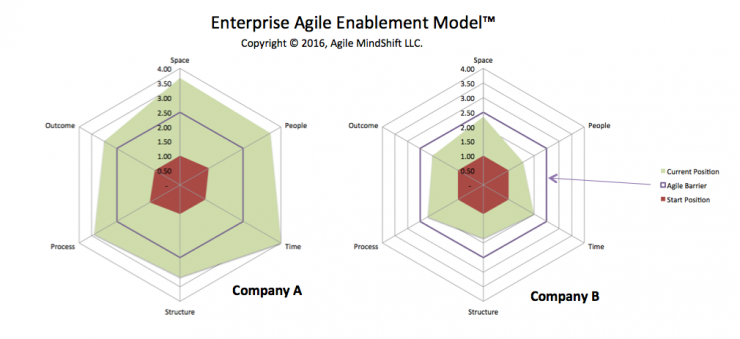
Successful ideas and cultures are nurtured by the ecosystems they inhabit. After the European settlers arrived at the shores of Plymouth in 1622, it would take about 150 years for more settlers to arrive, self-organize, build towns and learn how to self-govern. The combination of luck, confidence, dreams of freedom, and the distance from central authority manifested itself in a movement that led to the Declaration of Independence in July 4, 1776. The rest is history!
Similarly, organizations create an ecosystem for individuals to collaborate and work towards a common goal, and tend to differ greatly between each other, and these differences are an important component of their competitive advantage.
Leaders considering introducing agility into their organization, or have been at it for a while and see a stagnation of their agile transformation, need to examine the enablement drivers and use a balanced approach to set a strategic plan along those dimensions.
The ultimate goal of the strategy is to accelerate agile adoption because organizations, unlike the settlers of North America, don't have 150 years to realign their organization with agility, while competitors, technologies an the tech sector evolves every few months.
Enterprise Agile Enablement Model™ includes a list of key factors that influence agile adoption within organizations. It is based on lessons-learned from companies that have broken agile adoption barriers, and combines agile must-haves and best practices embraced by successful high-tech companies.
The model consists of six agile enablement drivers that work together to create an ecosystem for realizing agile benefits. The Enterprise Agile Enablement Model™ drivers are:
Space driver – consists of practices and policies that are geared to maximize collaboration, enabling high-bandwidth communication of Scrum teams and self-organization around real estate space in the company.
Space drivers include questions about utilization of space, whiteboards, information radiators, dining space, interruption free zones.
People driver –consists of values, policies, and practices that describe how the organization embraces and rewards Scrum teams, and how individual contributions are recognized and rewarded to support a collaborative agile culture.
People drivers include questions about cross-functional policies, team size, churn-rate, investment safeguards, education and trust.
Time driver – consists of practices, understanding and validation of how the organization perceives and defines time-related driver to support agile adoption.
Time drivers include questions about organizational cadence, Sprint synchronization and billing time.
Structure driver – consists of management practices and policies that enable or suppress agile adoption. These drivers are closely related to the management structure and the interaction between the central authorities and teams.
Structure drivers include questions about Manager roles, intellectual property protections, empirical learning, infrastructure, reward system and diffusion of agile mindset.
Process driver – consists of agile and information policies that affect the diffusion of agility throughout the organization.
Process drivers include questions about inspection, backlogs, product ownership and data sharing.
Outcome driver – consists of redefinition of expectations at the organizational level that lead to support agile adoption and realize agile benefits.
Outcome drivers include questions about increment expectations, operational outcomes, Kaizen, Impediments and definition of done.
Defining Your Agile Strategic Plan
Given that the Enterprise Agile Enablement Model™ is a strategic planning tool to enable agile adoption in the organization, it is used to support enterprise initiatives and team-level agile frameworks such as Scrum, LeSS, SAFe, DaD, Agile Streams, Nexus, etc..
Agile Strategies, like agile plans, require frequent inspect and adapt to capture failures early and reinforce success when it happens. To make that happen, executives and leaders start with a strategic plan as management experiments focused on the Enterprise Agile Enablement Model™ drivers, and adjust the plan through inspect and adapt feedback loops.
The model includes thirty-three factors, and the goal for each of the strategic initiatives is to move the factor index to an enablement stage outside the Agile Barrier to create a favorable ecosystem for agile adoption.

Figure 1. Using the Enterprise Agile Enablement Model™ to understand the agile responsiveness and alignment of companies A and B.
The Enterprise Agile Enablement Model™ provides a visual representation of your enterprise agile enablement index (see figure 1), where the red area represents your starting point (status quo), and the green area represents the current position along the agile enablement drivers.
The purple boundary, represents the Agile Barriers to adoption. Enterprises that have the majority of their enablement drivers within the purple boundary, are at higher risk of reverting to their status quo and losing a considerable amount of its investments in agile. That is illustrated in company B shown in Figure 1, where all of the six drivers well below the Agile Barriers to sustain agile adoption in the organization. While company A is well beyond the Agile Barriers and enjoys a great of agile responsiveness throughout the organization, giving it a considerable competitive advantage.
If you are interested in learning more about EAEM and how to use it, grab your copy of Guide to Enterprise Agile Enablement Model™ from Amazon.com (https://www.amazon.com/dp/1976770424)
